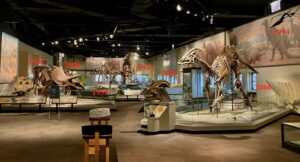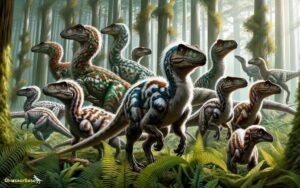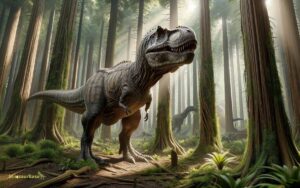What Dinosaurs Lived in England
Many are unaware that England's green and pleasant lands once roamed with giants and predators, far removed from the sheep and cattle that graze its fields today.
This region's geological past reveals a rich tapestry of dinosaur species, from the fearsome Baryonyx, a fish-eating predator that stalked the early Cretaceous rivers, to the iconic Iguanodon, which left its mark on both the landscape and paleontology itself.
Each species tells a story of adaptation and survival in an ever-changing world. Uncovering these stories offers not only a glimpse into England's prehistoric life but also prompts a broader reflection on the planet's deep history and the forces that have shaped it.
Key Takeaways
- England was home to a diverse range of dinosaurs, from the massive sauropods to the agile Hypsilophodon.
- Predatory dinosaurs in Early Cretaceous England displayed complex behaviors, including ambush hunting and seasonal prey targeting.
- Armored herbivores like Polacanthus and Scelidosaurus thrived in England's ancient landscapes, showcasing a variety of adaptive strategies.
- Significant discoveries, such as the fish-eating Baryonyx and the early tyrannosaur Eotyrannus, highlight England's rich dinosaur history.
The Jurassic Giants
During the Jurassic period, England was a stomping ground for colossal dinosaurs, whose fossilized remains provide critical insights into their evolutionary history and ecological interactions. These giants, thriving in what was then a much warmer climate, dominated the terrestrial landscapes.
Scientific analysis reveals a diverse ecosystem, where sauropods likely towered over the lush vegetation, their long necks enabling them to reach high foliage. Theropods, on the other hand, showcased a range of adaptations, indicating a complex food web with multiple predatory niches.
The presence of such varied species underscores England's role as a key area for Jurassic biodiversity. Researchers meticulously study the morphology of these fossils, piecing together the life habits and survival strategies of these ancient creatures, thereby enriching our understanding of prehistoric life.
Early Cretaceous Hunters
The transition into the Early Cretaceous period marks a pivotal era in England's prehistoric timeline, characterized by the emergence of adept predatory dinosaurs. Recent excavations have shed light on their sophisticated hunting behaviors, revealing strategies that underscore their dominance in this epoch.
These significant finds not only identify new species but also refine our understanding of their ecological niches and survival mechanisms.
Predatory Behaviors Uncovered
Recent discoveries have unveiled that early Cretaceous hunters in England employed complex predatory behaviors, suggesting a higher level of strategic hunting than previously believed. Analysis of fossilized remains and sedimentary layers provided insights into their tactics, including:
- Ambush hunting: Evidence suggests these dinosaurs utilized natural vegetation for concealment, ambushing prey unexpectedly.
- Cooperative hunting: Isotopic analysis indicates a social structure that could support coordinated attacks, enhancing their success rate.
- Exploitation of terrain: Geological findings reveal that these predators capitalized on rugged landscapes to corner or surprise prey.
- Seasonal prey targeting: Fluctuations in prey availability, inferred from fossilized flora and fauna, suggest these hunters adapted their strategies seasonally to exploit different prey populations.
This nuanced understanding underscores the adaptive capabilities and ecological roles of these ancient predators within their environments.
Significant Finds Identified
Building on the understanding of complex predatory behaviors, researchers have now identified several significant finds that shed light on the species and tools these early Cretaceous hunters in England utilized.
Among these, the discovery of Baryonyx walkeri remains stands out, highlighting a specialized predator with adaptations for fish-catching, such as elongated snouts and serrated teeth. Further excavation revealed theropod fossils, indicative of a diverse carnivorous ecosystem.
These findings, analyzed through comparative anatomy and isotopic analysis, suggest a nuanced food web where these dinosaurs occupied specific niches. This research not only enriches our understanding of Cretaceous-era England's ecological dynamics but also underscores the adaptability and specialization of theropod dinosaurs in response to available prey and environmental challenges.
Armored Herbivores Unveiled
Unveiling the armored herbivores of England's ancient landscapes reveals a diverse group of dinosaurs characterized by their protective body armor and plant-based diet. These dinosaurs, known for their formidable defenses against predators, played a crucial role in the ecosystems of their time.
- Polacanthus: This genus features heavily armored bodies and spikes, designed for protection and deterrence.
- Hylaeosaurus: Identified as one of the earliest discoveries of armored dinosaurs, it showcases long spines along its body.
- Sarcolestes: A lesser-known genus that highlights the diversity of England's armored herbivores.
- Scelidosaurus: It's distinguished by its unique osteoderms that covered its body, offering insights into the evolutionary adaptations for defense.
These species reflect the adaptive strategies that allowed herbivorous dinosaurs to thrive amidst the challenges of their prehistoric environments.
The Reign of Iguanodon
Amid the diverse landscape of prehistoric England, the Iguanodon stood out as a dominant herbivore, its evolutionary success underpinning its lengthy reign.
This dinosaur species thrived during the Early Cretaceous period, approximately 130 to 120 million years ago.
The Iguanodon's remarkable adaptation to its environment is evident in its physical characteristics. It possessed large, thumb spikes, likely used for defense against predators, and strong, beak-like jaws equipped for processing a variety of vegetation. These features indicate a highly specialized diet and an ability to navigate the challenges of its ecosystem.
Fossil evidence suggests that Iguanodons lived in herds, a social structure that could have provided additional protection from predators and facilitated foraging.
Their widespread presence across what's now Europe underscores their significance in the Mesozoic era's dinosaur communities.
Baryonyx: Fish-Eating Predator
While the Iguanodon thrived on land, the Baryonyx carved out a niche as a formidable fish-eating predator in the waterways of prehistoric England. This theropod dinosaur is notable for several distinct features that enabled its piscivorous lifestyle:
- Long, narrow snout: Much like modern crocodiles, this adaptation was perfect for catching fish.
- Hook-like claw: A large claw on each hand helped Baryonyx to snag slippery prey from the water.
- Cone-shaped teeth: Unlike the serrated teeth of many carnivores, Baryonyx had numerous cone-shaped teeth, ideal for piercing and holding onto fish.
- Evidence of diet: Fossilized remains have included fish scales and bones, directly linking Baryonyx to a diet predominantly consisting of fish.
This unique combination of features underscores Baryonyx's adaptation to a semi-aquatic life, highlighting its role as a specialized predator within England's prehistoric ecosystems.
Megalosaurus: England's First Dinosaur
Shifting focus from the aquatic predator Baryonyx, we now explore Megalosaurus, recognized as England's first scientifically described dinosaur, marking a pivotal moment in paleontological history.
Unearthed in the 17th century, its remains puzzled scholars until 1824, when William Buckland formally identified them, placing Megalosaurus at the forefront of dinosaur science. This theropod, thriving in the Middle Jurassic period, approximately 166 million years ago, roamed the landscapes that are now England.
Characterized by its large size, bipedal stance, and carnivorous diet, Megalosaurus fundamentally shaped the early understanding of dinosaurs. Its discovery initiated the study of these prehistoric giants, laying the groundwork for future paleontological discoveries and significantly contributing to the field's development.
The Mysterious Neovenator
Venturing into the shadowy realms of prehistoric England, the Neovenator emerges as a compelling subject of study due to its distinctive features and the enigmatic nature surrounding its existence. Discovered in the late 20th century, this carnivorous dinosaur has piqued the interest of paleontologists worldwide.
- Size and Stature: Neovenator was notably large, with estimates suggesting a length of up to 7.6 meters.
- Distinctive Features: It possessed a unique combination of skeletal characteristics, including elongated nostrils and a plethora of sensory receptors along its snout.
- Dietary Habits: Analysis of its teeth and jaw structure intimates a diet predominantly consisting of medium to large-sized prey.
- Evolutionary Significance: Its discovery has provided valuable insights into the predatory dinosaur lineage in Europe, challenging previous notions about the diversity and distribution of theropods.
This intriguing dinosaur continues to be a focal point for understanding prehistoric ecosystems in England.
Scelidosaurus: A Jurassic Armored Dinosaur
Exploring the diverse landscape of prehistoric England, we encounter Scelidosaurus, a Jurassic era dinosaur renowned for its armored body, offering a stark contrast to the predatory nature of Neovenator. This herbivorous dinosaur, which thrived approximately 191 to 183 million years ago during the Early Jurassic period, is distinguished by its elongated body covered in protective osteoderms. These bony plates, coupled with its quadrupedal stance, suggest Scelidosaurus was well-adapted to fend off predators.
Paleontologists have painstakingly reconstructed its anatomy from fossils primarily found in what's now Dorset, providing invaluable insights into its lifestyle. Analysis of its limb structure indicates a slow-moving but capable walker, likely foraging near ground level. Its discovery enriches our understanding of the evolutionary pathways that led to the diverse array of armored dinosaurs.
Cetiosaurus: England's Sauropod
Cetiosaurus, England's significant contribution to sauropod paleontology, offers a fascinating glimpse into the Jurassic period through its discovery timeline.
Detailed analysis of its anatomy reveals a creature of immense size, challenging previous assumptions about the scale and nature of Early Jurassic sauropods.
This discussion aims to explore the nuances of Cetiosaurus's discovery and its implications for understanding sauropod evolution and morphology.
Cetiosaurus Discovery Timeline
The discovery of Cetiosaurus, a significant sauropod dinosaur from England, traces back to the early 19th century, marking a pivotal moment in paleontological history. This period was characterized by heightened curiosity and rigorous scientific endeavors, leading to groundbreaking findings.
- 1824: The first bones attributed to Cetiosaurus were described by William Buckland, although they were initially thought to belong to a giant marine reptile.
- 1841: Richard Owen recognized these bones as belonging to a dinosaur, coining the term 'Dinosauria' during this period.
- 1871: Further excavations led by Phillips unearthed more complete skeletons, providing clearer insights into its structure.
- 1927: A comprehensive study by Charles W. Andrews offered a detailed description of Cetiosaurus, solidifying its importance in dinosaur research.
These milestones encapsulate the discovery timeline of England's notable sauropod, contributing significantly to the understanding of Jurassic-era fauna.
Anatomy and Size Insights
Delving into the anatomy and size of Cetiosaurus reveals that this Jurassic giant measured up to 18 meters in length, showcasing a robust skeletal structure characteristic of sauropods. Its long neck, believed to contain over 12 vertebrae, allowed it to reach vegetation at various heights, an adaptation vital for its herbivorous diet.
The limb bones, particularly the femur and humerus, exhibit significant girth and length, supporting its massive body and suggesting a strong musculature. Tail vertebrae indicate a lengthy and possibly flexible tail, contributing to its balance and mobility.
Furthermore, the discovery of pneumatic cavities within some bones points to an advanced respiratory system, optimizing oxygen intake for such a large creature. These anatomical features underscore Cetiosaurus's adaptability and survival in the Jurassic ecosystem of England.
Eotyrannus: The Dawn of Tyrants
In the early Cretaceous period, Eotyrannus emerged as a significant precursor to the later, more formidable tyrannosaurids, marking a critical evolutionary juncture in the history of theropod dinosaurs. This relatively small yet impactful predator showcased features that hinted at its descendants' dominance in later periods.
- Size and Structure: Eotyrannus was notably smaller than its famous relative, Tyrannosaurus rex, but its anatomical features suggest a swift, agile predator.
- Teeth and Diet: Equipped with numerous sharp teeth, it likely preyed on smaller dinosaurs and other contemporary creatures.
- Geographical Significance: Its fossils, found in England, provide valuable insights into the distribution of early tyrannosaurs.
- Evolutionary Role: Eotyrannus represents a key link in understanding the evolution and spread of tyrannosaurids across ancient landmasses.
The Flight of Ornithocheirus
The Ornithocheirus, a prehistoric flyer, boasted significant dimensions and distinctive anatomical features that facilitated its mastery of the skies.
Its habitat and hunting patterns reflect a highly adapted lifestyle, closely linked to the coastal regions of what's now England.
Fossil discoveries across England have provided critical insights into its existence, shedding light on the creature's behaviors and ecological role during the Cretaceous period.
Ornithocheirus Size and Anatomy
Ornithocheirus, a pterosaur known for its impressive wingspan, exhibited a size and anatomy uniquely adapted for long-distance flight. This creature's physical characteristics were a marvel of prehistoric aviation, reflecting an evolutionary design optimized for efficiency and endurance in the air.
- Wingspan: Estimates suggest it reached up to 10 meters, allowing for sustained glide over vast distances.
- Lightweight Skeleton: Composed of hollow bones, reducing overall weight without compromising structural integrity.
- Large Pectoral Muscles: Powered its massive wings, enabling both powerful takeoffs and agile maneuvers.
- Aerodynamic Body Shape: Minimized air resistance, enhancing flight efficiency and speed.
Ornithocheirus's anatomy was a testament to the evolutionary ingenuity of pterosaurs, showcasing adaptations that facilitated its existence as a formidable aerial predator.
Habitat and Hunting Patterns
Understanding the impressive size and anatomy of Ornithocheirus sheds light on its habitat and hunting patterns, revealing how these factors were intricately connected to its aerial dominance.
With wingspans reaching up to 10 meters, Ornithocheirus soared above open waters, primarily relying on its keen eyesight to spot prey from great heights.
This pterosaur inhabited coastal environments, where it could easily access a diverse range of fish and small marine creatures. Its long, pointed beak was perfectly adapted for snatching prey from the ocean's surface during flight, minimizing energy expenditure.
The choice of habitat allowed Ornithocheirus to exploit a niche where aerial agility and hunting efficiency were paramount, demonstrating a sophisticated adaptation to its ecological role.
This strategic selection of habitat and hunting technique underscores Ornithocheirus's evolutionary success in the Cretaceous period.
Fossil Discoveries in England
England's rich geological strata have yielded numerous Ornithocheirus fossils, providing invaluable insights into the pterosaur's evolutionary journey and the environmental dynamics of the Cretaceous period. The discovery of these fossils has had a profound impact on our understanding of prehistoric life in England, highlighting:
- The wide geographical distribution of Ornithocheirus, indicating a vast habitat range.
- Variations in size and morphology among specimens, suggesting a complex evolutionary history.
- Evidence of flight capabilities, shedding light on the aerodynamics of pterosaurs.
- Insights into the ecosystem's biodiversity, illustrating the interconnectedness of terrestrial and aerial faunas.
These findings underscore the significance of England's fossil record in unraveling the mysteries of prehistoric life, offering a window into the past that continues to fascinate scientists and enthusiasts alike.
Camptosaurus: A Plant-Eating Wanderer
Camptosaurus, a herbivorous dinosaur, roamed vast territories during the Late Jurassic period, showcasing adaptability in its quest for vegetation. This dinosaur's anatomical structure suggests a highly versatile diet, allowing it to thrive in diverse environments. Its dentition was particularly well-suited for processing a variety of plant materials, indicating a broad dietary niche. Additionally, Camptosaurus's limb morphology hints at a lifestyle that was both terrestrial and potentially semi-bipedal, providing it with the agility to traverse different terrains in search of food.
The fossil record of Camptosaurus in England adds a significant chapter to our understanding of Jurassic ecosystems. These findings underscore the dinosaur's widespread distribution and its role as a key herbivore. Its presence in England during this era highlights the region's rich prehistoric biodiversity and the dynamic ecosystems that once flourished there.
Discovering Hypsilophodon: The Forest Dweller
While Camptosaurus showcased the adaptability of herbivorous dinosaurs in diverse environments, Hypsilophodon, another herbivore, thrived within the dense forests of England, offering insights into its unique lifestyle and ecological niche.
- Small and Agile: Unlike its contemporaries, Hypsilophodon was relatively small, allowing it to navigate through dense vegetation with ease.
- Diet: Its teeth were well-suited for a diet of tough, fibrous plants found in forested areas.
- Social Behavior: Evidence suggests that Hypsilophodon lived in groups, which could have offered protection against predators.
- Nesting Habits: Recent findings indicate that they built nests, which sheds light on their reproductive strategies and parental care.
This small, yet fascinating dinosaur contributes significantly to our understanding of the diversity and complexity of dinosaur life in ancient England.
Conclusion
In sum, England's Mesozoic era was a bustling stage of evolutionary marvels, hosting an array of dinosaurs from the colossal Jurassic giants to the cunning Cretaceous predators.
Among these, the Iguanodon stands out, with estimates suggesting up to 35 individuals per square kilometer in certain regions, illustrating the dense and dynamic ecosystems they thrived in.
This statistic not only underscores the Iguanodon's significance in England's prehistoric narrative but also highlights the intricate balance and biodiversity of these ancient habitats.






